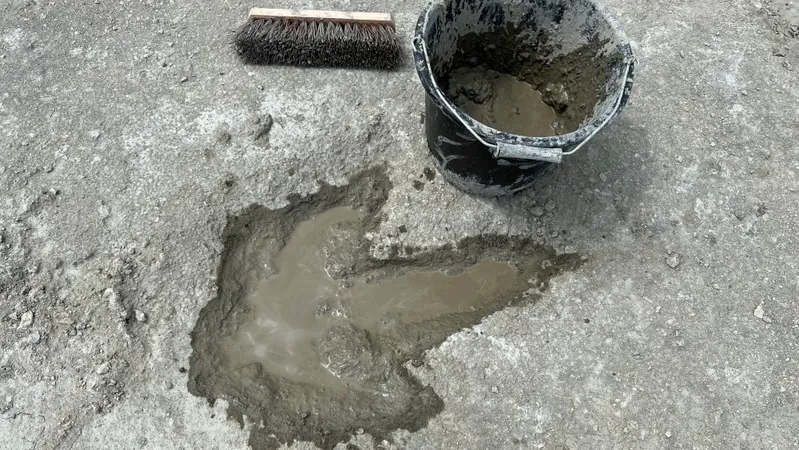
Unveiling a "Dinosaur Highway": Stunning 166-Million-Year-Old Tracks Discovered in England
2025-01-02
Author: Noah
LONDON - A remarkable discovery has shaken the foundations of paleontology
as worker activity within a limestone quarry in southern England has unveiled what has been dubbed a "dinosaur highway." This incredible find reveals almost 200 dinosaur tracks dating back an astounding 166 million years, according to researchers.
Excavation at Dewars Farm Quarry
The groundbreaking excavation took place at the Dewars Farm Quarry in Oxfordshire, spearheaded by a dedicated team of over 100 researchers who commenced work in June. This significant discovery grows upon previous paleontological studies in the region and offers a deeper understanding of the Middle Jurassic period, known for its lush, tropical ecosystems that were home to some of history’s largest creatures.
Insights from Paleontologists
According to Kirsty Edgar, a micropaleontology professor at the University of Birmingham, “These footprints offer an extraordinary window into the lives of dinosaurs, revealing details about their movements, interactions, and the tropical environment they inhabited.”
Diverse Dinosaur Tracks
Among the tracks, four distinct sets are attributed to the massive sauropods, specifically the Cetiosaurus, reaching lengths of nearly 60 feet (18 meters). Additionally, a fifth track set corresponds to the fearsome Megalosaurus, a predator that measured approximately 30 feet (9 meters) in length and was the first dinosaur to be scientifically described two centuries ago. The tracks illuminate a fascinating potential interaction zone where herbivores and carnivores coexisted, raising intriguing questions about their behaviors.
Significance of Megalosaurus Discovery
Emma Nicholls, a vertebrate paleontologist from the Oxford University Museum of Natural History, emphasized the importance of the Megalosaurus, stating, “Scientists have known about and been studying Megalosaurus for longer than any other dinosaur on Earth, and yet these recent discoveries prove there is still new evidence of these animals out there, waiting to be explored.”
Comparison to Previous Discoveries
This site is particularly significant because nearly three decades ago, researchers discovered 40 sets of dinosaur footprints in a nearby limestone quarry, which at the time was deemed one of the world’s most important sites of its kind. Unfortunately, that earlier site has become largely inaccessible, with limited photographic documentation due to the era’s lack of advanced recording technology.
Advanced Documentation of Findings
In contrast, this summer's team documented their findings with over 20,000 digital images and utilized drones to create intricate 3-D models of the tracks. This wealth of documentation is expected to enhance future studies and provide key insights into the size, gait, and speed of these magnificent dinosaurs.
Reconstructing the Ancient Environment
Earth scientist Duncan Murdock from the Oxford museum noted the impressive preservation of the tracks, stating, “We can see how the mud was deformed as the dinosaur’s feet squelched in and out. Along with other fossils like burrows, shells, and plants, we can vividly reconstruct the muddy lagoon environment the dinosaurs traversed.
Upcoming Exhibit and Media Coverage
To celebrate this extraordinary achievement, the findings will be showcased in a new exhibit at the Oxford University Museum and will be featured in an upcoming episode of the BBC's “Digging for Britain,” highlighting the thrilling world of paleontological research. This discovery not only enriches our knowledge of dinosaurs but also reminds us of the vast narratives yet to be uncovered buried beneath our feet. Don't miss the chance to witness the history of our planet and the creatures that roamed it!









 Brasil (PT)
Brasil (PT)
 Canada (EN)
Canada (EN)
 Chile (ES)
Chile (ES)
 España (ES)
España (ES)
 France (FR)
France (FR)
 Hong Kong (EN)
Hong Kong (EN)
 Italia (IT)
Italia (IT)
 日本 (JA)
日本 (JA)
 Magyarország (HU)
Magyarország (HU)
 Norge (NO)
Norge (NO)
 Polska (PL)
Polska (PL)
 Schweiz (DE)
Schweiz (DE)
 Singapore (EN)
Singapore (EN)
 Sverige (SV)
Sverige (SV)
 Suomi (FI)
Suomi (FI)
 Türkiye (TR)
Türkiye (TR)